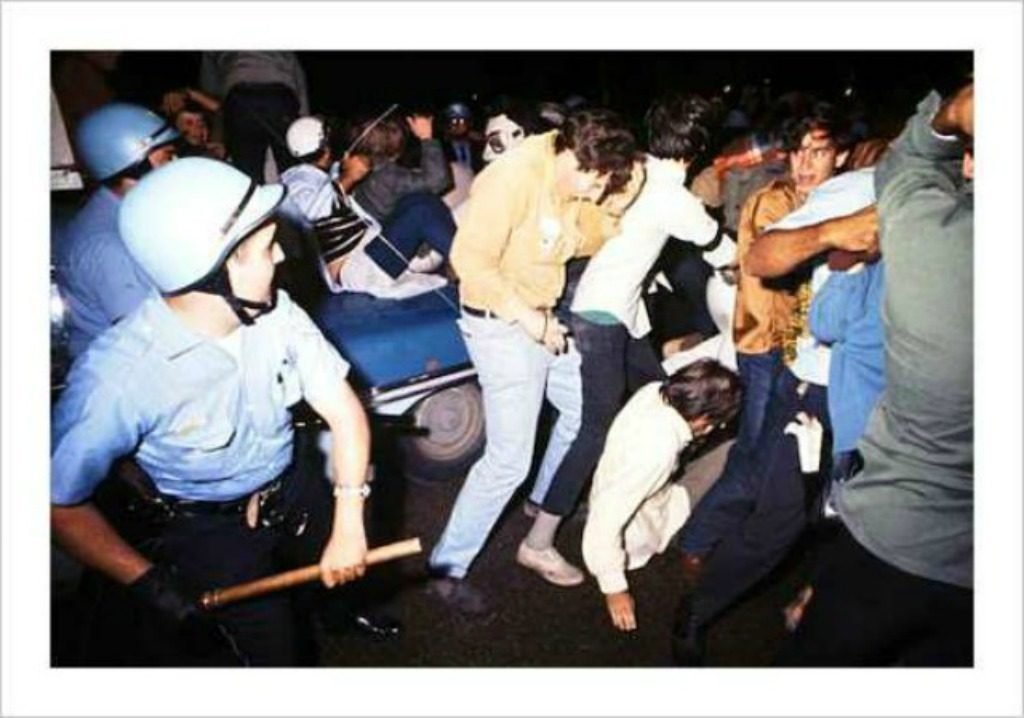In January 1968, Americans back at home watched in horror as General Westmoreland’s troops in Vietnam engaged in a Tet Offensive that claimed between 10,000 and 15,000 Vietnamese lives along with 205 U.S. soldiers. The civil rights movement had hit its fever pitch, and then in February Defense Secretary Robert McNamara resigned from his post after concluding that the United States could not win the war.
In January 1968, Americans back at home watched in horror as General Westmoreland’s troops in Vietnam engaged in a Tet Offensive that claimed between 10,000 and 15,000 Vietnamese lives along with 205 U.S. soldiers. The civil rights movement had hit its fever pitch, and then in February Defense Secretary Robert McNamara resigned from his post after concluding that the United States could not win the war.
It was a disturbing period in American politics magnified by a wide chasm between left and right reflective of today’s divide. Everyone appeared to be on the march to declare their causes: African-Americans, Mexican-Americans, European socialists, feminists, environmentalists and pacifists. Often these diverse groups all coalesced under the Hippie banner, though drug culture did not permeate through all of these causes and organized protests were separate from one another.

Mounted policemen watch a protest march in San Francisco on April 15, 1967. (Wikimedia Commons)
One of the most egregious cases of peaceful protest meeting brute force happened in Chicago at the 1968 Democratic National Convention.
Leading up to it, Sen. Eugene McCarthy and President Lyndon B. Johnson were early favorites to win the nomination, but after McCarthy stunned LBJ in New Hampshire’s primary, the president bowed out of the contest. That paved the way for Robert F. Kennedy to jump into the race, but he was assassinated on June 5 creating deeper divisions in the party and in the country. Vice President Hubert Humphrey also entered the race, but did not compete in any primaries and instead accrued delegates through questionable caucuses that were controlled by party leaders.
Here, we look to answer exactly what led up to the events of the ’68 DNC:
Q: What was the climate like during the summer of Chicago in 1968?
The weather was hot and humid, and a/c, elevators and pay phones were operating capriciously while Taxi drivers were on strike throughout the city, while a heavy police presence created an unnerving and unwelcome environment that stood in contrast to the “HELLO DEMOCRATS! WELCOME TO CHICAGO” sign hung at the city’s gates.

Q: Did the Chicago mayor do anything to contribute to the climate?
Mayor Richard J. Daley, thought to be the country’s second-leading Democrat behind only President Lyndon B. Johnson, had steel fences topped with barbed wire erected at the site of the convention to go along with new doors which had been bulletproofed.

International Ladies’ Garment Workers’ Union supporters hold signs during a Humphrey rally (Wikimedia Commons)
Q: Who was welcomed to the convention?
Delegates and party leaders from all 50 states. His assassination meant that RFK’s 393.5 delegates were uncommitted, and could commit to any one of the candidates running. Anti-War March This demonstration took place as Chicago was preparing to host the Democratic National Convention

Anti-War protesters in Chicago for the 1968 DNC (Wikimedia Commons)
Q: Who showed up to the convention?
Delegates, party leaders and a plethora of protesters. After 80 percent of the primary voters had voted for anti-war candidates such as McCarthy, the Democrats decided to award Vice President Hubert H. Humphrey with enough delegates to win the nomination. The news coming from inside added fuel to an already raging fire going on outside, where things got nasty in a hurry.

Illinois delegates react at_ 968 DNC (Wikimedia Commons)
Q: What did the people watching at home see?
At Mayor Daley’s direction, the Illinois National Guard joined the Chicago Police Department to meet roughly 10,000 protesters and attempt to instill order on the crowd by any means necessary. Protesters were clubbed and beaten, and sprayed with toxic chemicals with fascist oppression and many of them were jailed. Among the opponents of Humphrey’s pro-war politics and the undemocratic selection of candidates, were the Youth International Party (Yippies), the Students for a Democratic Society, the National Mobilization Committee to End the War in Vietnam, the Black Panther Party and other apathetic voters who felt the political establishment had failed them. Journalists and TV anchors were not excluded from the violent beatdown.

Mad Men screen grab (YouTube)
Q: Who were the “Chicago Eight” and what happened to them?
These were leaders of the various protest factions listed above, charged by the Justice Department on conspiracy and crossing state lines with the intention of inciting a riot. The so-called Chicago Eight included radical leftist and “Steal This Book” author Abbie Hoffman, Black Panthers co-founder Bobby Seale, counter-culture activist Tom Hayden, pacifist protester David Dellinger, Rennie Davis, John Froines, Jerry Rubin, and Lee Weiner.

Art Shay
Q: What happened after the convention?
In October, President Johnson ordered an end to the bombing of Northern Vietnam and tried to break a stalemate occurring in a similarly divided Paris, France. The thinking was that progress in France would help the Humphrey-Muskie ticket back home in the general election.

French workers with placard during occupation of their factory 1968 (Wikimedia Commons)
Q: What happened in the election?
Richard Nixon won a close election and on the shoulders of 301 electoral votes after third-party candidate George Wallace drew more than 9 million votes. By year’s end, the Americans had a troop strength of nearly 550,000.
Q: How did the Democratic Party respond moving forward?
The McGovern-Fraser Commission was created by the Democratic Party to do away with the influence held by party leaders, and in their place so-called “superdelegates” were instilled. As a result, many caucus states switched to primaries where over 80% of convention delegates are selected by the voters themselves.
